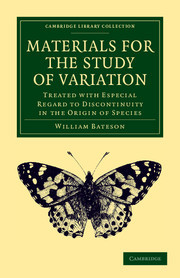Description
Materials for the Study of Variation
Treated with Especial Regard to Discontinuity in the Origin of Species
Cambridge Library Collection - Darwin, Evolution and Genetics Series
Author: Bateson William
Published in 1894, this pioneering work offers insight into how the study of genetics and inheritance itself evolved.
Language: English
Approximative price 61.17 €
In Print (Delivery period: 14 days).
Add to cart
Publication date: 08-2012
Support: Print on demand
Support: Print on demand
Description
/li>Contents
/li>
Building on the work of Darwin and Mendel, the biologist William Bateson (1861?1926) was the first scientist to combine the study of variation, heredity and evolution, and to use the term 'genetics'. This book was first published in 1894 after many years of experimental and theoretical work - particularly in the embryology of the acorn worm genus Balanoglossus - which had been guided by the principle that embryonic developmental stages replay the evolutionary transitions of adult forms of an organism's ancestors. Bateson was the first to challenge this theory, which made him unpopular among the scientific establishment of the time, but he was proved right. Organising his material by anatomical sections, Bateson explores speciation, phylogeny and discontinuous and continuous variation among a wide range of species, including vertebrates, invertebrates and plants. This pioneering work offers great insight into how the study of genetics and inheritance itself evolved.
Preface; Introduction; Part I. Meristic Variation: 1. Arrangement of evidence; 2. Segments of arthropoda; 3. Vertebrae and ribs; 4. Spinal nerves; 5. Variation in arthropoda; 6. Chaetopoda, hirundinea and cestoda; 7. Branchial openings of chordata and structures in connexion with them; 8. Mammae; 9. Teeth; 10. Teeth (recapitulation); 11. Miscellaneous examples; 12. Colour-markings; 13. Minor symmetries: digits; 14. Digits (recapitulation); 15. Minor symmetries: segments in appendages; 16. Radial series; 17. Radial series: echinodermata; 18. Bilateral series; 19. Further illustrations of the relationship between right and left sides; 20. Supernumary appendages in secondary symmetry; 21. Appendages in secondary symmetry; 22. Duplicity of appendages in arthropoda; 23. Secondary symmetry in vertebrates; 24. Double monsters; 25. Concluding reflexions; Index of subjects; Index of persons.
© 2024 LAVOISIER S.A.S.
These books may interest you

Problems of Genetics 34.17 €



